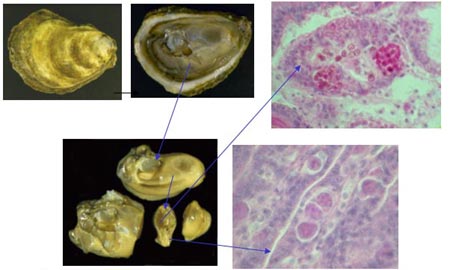|
|
||||||||||
|
|
|
|
|
|
||||||
|
|
||||||||||

Science Information By:
Backgrounder
- MSX Disease of American (Eastern) Oysters
What is MSX Disease?
This disease is caused by a microscopic parasite – too small to see with
the naked eye – with the scientific name Haplosporidium nelsoni. MSX stands
for “Multinucleate Sphere X” which was what the parasite was first called
when discovered in Chesapeake Bay American (or Eastern) oysters (Crassostrea
virginica) in the late 1950s.
Does it affect Human Health?
No. MSX is purely a health problem for the American oysters. In the United
States, oysters are routinely marketed from populations that carry MSX
with no human health concerns.
What does it look like?
Under a microscope, two stages of MSX can be detected in the oyster tissues:
(a) the ‘plasmodium’ which is the multinucleate stage that spreads throughout
the tissues and earned the parasite the name MSX; and
(b) the spore stage, which develops in the walls of the digestive ducts
of the oyster.

Oyster soft tissues removed from shell (bottom left) and “steak” cut
for microscope examination: spores in digestive gland (top right), plasmiodial
stage in gills (bottom right)
Where does it occur normally?
MSX has been reported from Pacific oysters (Crassostrea gigas) in Korea,
the Pacific coast of the US, and from France. However, MSX does not cause
serious disease in this species of oyster. In American oysters, however,
it causes mass mortalities and has seriously impacted eastern US stocks
in Chesapeake Bay. It occurs from Maine south to Florida, but most serious
disease losses occur in the Chesapeake-Delaware Bay area.
What does it do to the Oyster?
When the parasite enters the oysters tissues it multiplies and spreads.
The plasmodial stages can be found throughout the soft tissues, but by
the end of the summer spore stages start to develop in the walls of the
digestive tubules. All this causes tissue damage and gradual weakening
of the oysters until they start dying at the end of the summer. Some infected
oysters may survive over winter but fail to recover the following spring
so a second wave of mortality can be observed then. Oysters that have
survived mass mortalities show no further signs of infection until the
appearance of the plasmodial stage of MSX the following summer.
How does it spread?
MSX cannot be spread directly from oyster to oyster, but is readily picked
up by some unknown agent in the water. It is believed that MSX uses an
unknown, intermediate host to spread infection. Oysters that have been
exposed to salinities of 10 ppt and temperatures of 20 C over a period
of two weeks appear to lose their infections. Holding oysters in salinities
of less than 15 ppt may suppress the disease but not necessarily kill
the parasite.
Does it affect any other shellfish?
There is no evidence that MSX can cause disease in other bivalve molluscs,
such as clams, mussels and scallops. However, MSX could be accidentally
carried on or in other shellfish, thus, caution is required when moving
any shellfish from affected areas.
Who should I call if I find dying oysters?
If you find dying oysters, do not move them. Report them to one of the
following contacts:
• DFO Halifax – Dr René Lavoie (902) 426-2147
• DFO Moncton – Maurice Mallet (506) 851-3176, Mary Stephenson (506) 851-6983
• DFO Ottawa – Sharon McGladdery (613) 991-6855
October 2002